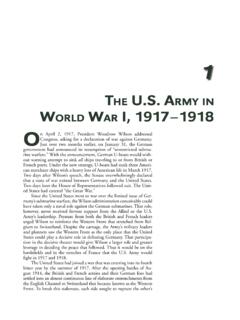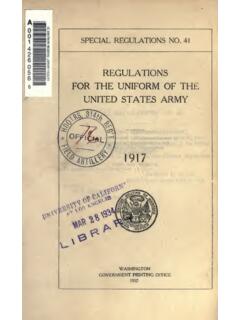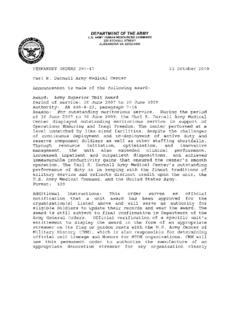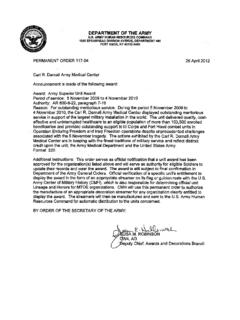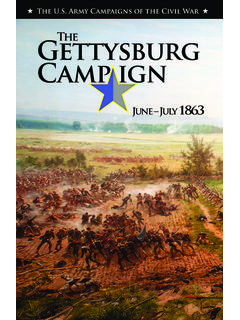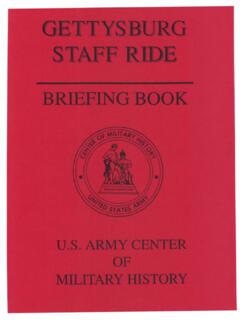Transcription of The Army and Reconstruction, 1865-1877
1 The Army Campaigns of the Civil War Army And The reconstruction 1865 1877. Cover: The Freedmen's Bureau, by Alfred R. Waud (Harper's Weekly, 25 July 1868). CMH Pub 75 18. Army And The reconstruction 1865 1877. by Mark L. Bradley Center of Military History United States Army Washington, , 2015. Introduction Although over one hundred fifty years have passed since the start of the American Civil War, that titanic conflict continues to matter. The forces unleashed by that war were immensely destruc- tive because of the significant issues involved: the existence of the Union, the end of slavery, and the very future of the nation.
2 The war remains our most contentious, and our bloodiest, with over six hundred thousand killed in the course of the four-year struggle. Most civil wars do not spring up overnight, and the American Civil War was no exception. The seeds of the conflict were sown in the earliest days of the republic's founding, primarily over the existence of slavery and the slave trade. Although no conflict can begin without the conscious decisions of those engaged in the debates at that moment, in the end, there was simply no way to paper over the division of the country into two camps: one that was dominated by slavery and the other that sought first to limit its spread and then to abolish it.
3 Our nation was indeed half slave and half free, and that could not stand. Regardless of the factors tearing the nation asunder, the soldiers on each side of the struggle went to war for personal reasons: looking for adventure, being caught up in the passions and emotions of their peers, believing in the Union, favoring states' rights, or even justifying the simple schoolyard dynamic of being convinced that they were worth three of the soldiers on the other side. Nor can we overlook the factor that some went to war to prove their manhood. This has been, and continues to be, a key dynamic in understanding combat and the profes- sion of arms.
4 Soldiers join for many reasons but often stay in the fight because of their comrades and because they do not want to seem like cowards. Sometimes issues of national impact shrink to nothing in the intensely personal world of cannon shell and mini ball. Whatever the reasons, the struggle was long and costly and only culminated with the conquest of the rebellious Confederacy, 5. the preservation of the Union, and the end of slavery. These campaign pamphlets on the American Civil War, prepared in commemoration of our national sacrifices, seek to remember that war and honor those in the United States Army who died to preserve the Union and free the slaves as well as to tell the story of those American soldiers who fought for the Confederacy despite the inherently flawed nature of their cause.
5 The Civil War was our greatest struggle and continues to deserve our deep study and contemplation. RICHARD W. STEWART, Chief of Military History 6. The Army and reconstruction 1865 1877. Strategic Setting Within two months of Confederate General Robert E. Lee's surrender at Appomattox Court House on 9 April 1865, the Confederacy had collapsed, and its armed forces had ceased to exist. The systematic destruction of the South's transportation, manufacturing, and industrial facilities during the closing months of the war had ensured the futility of further armed resistance.
6 It also made a swift economic recovery next to impossible, leaving ex-Confederates destitute and bitter over their harsh fate. The bloodiest war in history final death toll estimates range from 600,000 to over 800,000 fighting men had settled the critical issues of secession and slavery but left much else unresolved, above all the former slaves' civil, political, and economic status in the postwar South. In the spring of 1865, the Army faced the unprecedented task of occupying eleven conquered Southern states during peacetime and administering reconstruction the process by which the former rebellious states would be restored to the Union.
7 Two decades earlier, the Army had performed occupation 7. duty in Mexico both during and after the Mexican War, but that was on foreign soil, and reconstruction was never a part of the Army's mission there. The postwar occupation of California and New Mexico did provide Army officers with some experience in nation-building, requiring them to draft laws and constitutions for the territories recently annexed from Mexico. During the Civil War, the Army oversaw wartime reconstruction in areas of Virginia, Tennessee, Louisiana, and Arkansas, giving it invaluable experience in the kind of stabiliza- tion and peacekeeping missions it would later perform across the entire South.
8 On 24 April 1863, the War Department issued General Orders 100, the Union Army's official code of conduct in the field. Drafted by Francis Lieber, an eminent legal scholar, and a panel of Army officers, Lieber's Code induced several European nations to draft similar documents for their armies. For all its virtues, Lieber's Code exerted little influence on the Union Army's conduct during the Civil War, in part because the Army operated under the assump- tion that such matters should be left to the local commanders'. discretion. Given these circumstances, it is hardly surprising that the Army entered its postwar occupation duties with neither a plan nor a doctrine to govern its actions.
9 (See Map 1.). Worse yet, the Constitution provided no guidance on how the rebellious states should be restored, provoking heated debate as to what reconstruction entailed. On 8 December 1863, President Abraham Lincoln issued his Proclamation of Amnesty and reconstruction , offering a full pardon and restoration of rights to persons who resumed their allegiance to the Union by taking a loyalty oath and pledging to support the abolition of slavery. The proclamation excluded only a few classes of high-ranking Confederate civilian and military leaders. When those taking the loyalty oath in any Southern state amounted to 10 percent of the votes cast in 1860, the loyal minority could establish a new state government with representation in Congress, provided its consti- tution abolished slavery.
10 Deeming Lincoln's Ten Percent Plan too lenient, the Radical Republicans in Congress introduced their own plan . known as the Wade-Davis bill in July 1864. Under its provi- sions, reconstruction would not start until the majority of a state's white male voters pledged to support the Constitution. Only then could a state hold an election for delegates to a consti- tutional convention, with voting restricted to those who could 8. take the Ironclad Oath affirming that they had never willingly supported the Confederacy. Lincoln killed the bill with a pocket veto, fearing that it would compel him to repudiate the Southern state governments established under his Ten Percent Plan.
